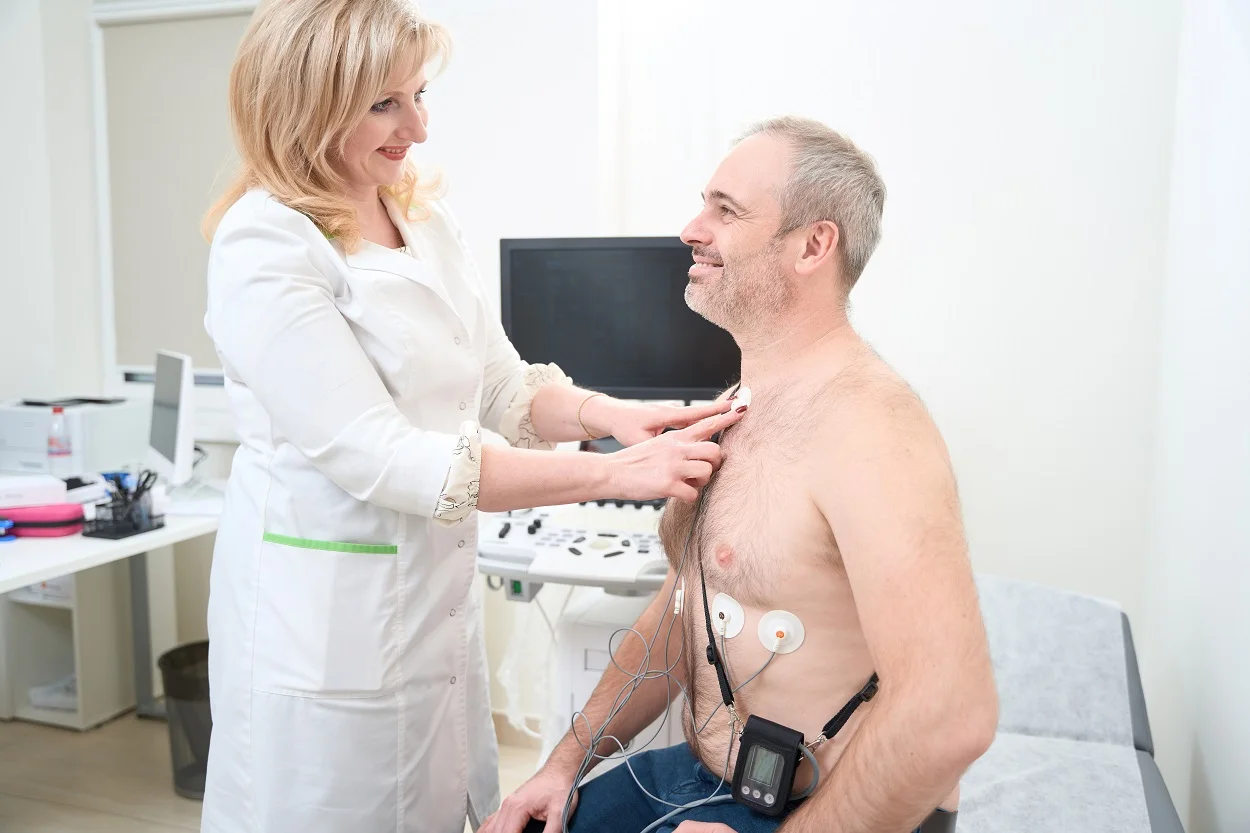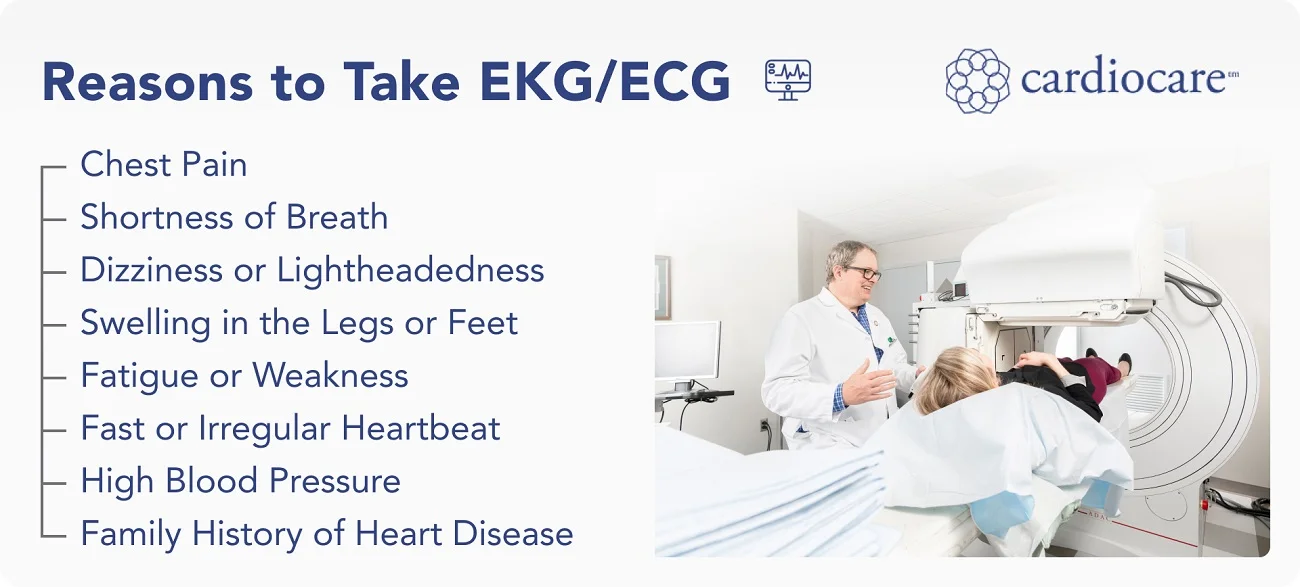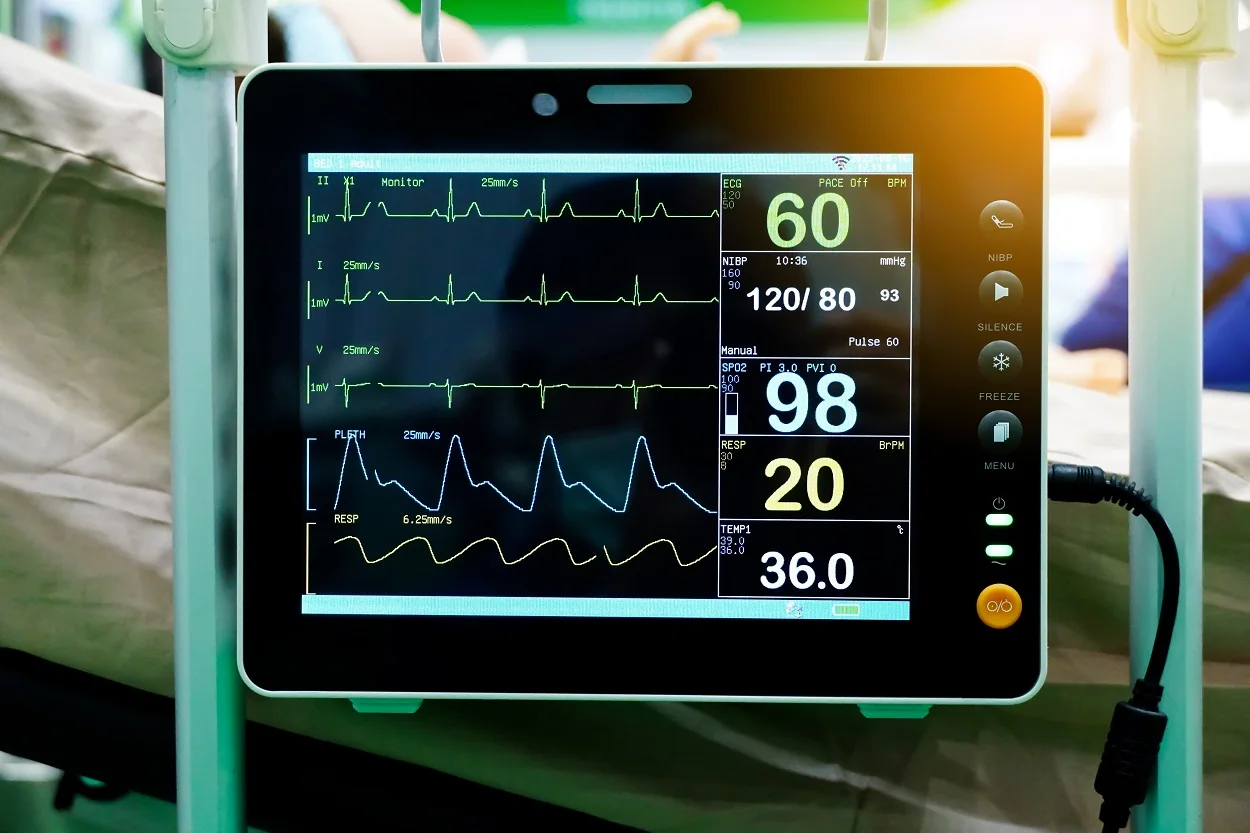What Is the Difference Between ECG and EKG?
Knowledge is power, especially when it comes to your heart health. The terms EKG/ECG are often used interchangeably which could lead to confusion.
In this blog post, CardioCare will clarify any uncertainty surrounding these terms and explore their applications. Then, we’ll explore the critical role they play in diagnosing specific medical conditions.
Are EKG and ECG Tests the Same?

Yes! Regardless of the abbreviation used, both refer to the identical procedure: the recording of the heart’s electrical activity using electrodes placed on the skin’s surface. While they are sometimes referred to using different names, an EKG and an ECG are the same test.
The discrepancy between EKG vs. ECG stems from the difference in spelling conventions between American English and German. “EKG” represents the German spelling of the term, which is Elektrokardiogramm, while “ECG” is the abbreviation for electrocardiogram in American English.
| Feature | EKG | ECG |
|---|---|---|
| Full Name | Elektrokardiogramm | Electrocardiogram |
| Abbreviation Origin | German | English |
| Meaning | Electrocardiogram | |
| Procedure | Electrodes are placed on the chest, arms, and legs to record the heart’s electrical activity. | |
| Results | Waveform graph showing the heart’s electrical activity; interpreted by a healthcare professional to assess heart rate, rhythm, and conduction. | |
| Clinical Use | Diagnoses heart conditions (arrhythmias, heart attacks, etc.), monitors heart health, and guides treatment plans. | |
What Is the Purpose of EKG and ECG?
The EKG or ECG test serves as a critical diagnostic tool for healthcare professionals. It’s a non-invasive procedure that provides a detailed visual representation of the heart’s electrical activity, revealing the strength, timing, and consistency of the electrical impulses that regulate your heartbeat. Doctors will analyze the waves produced on the graph to assess various aspects of your heart’s function, including:
- Heart Rate: The speed at which your heart beats. An abnormal EKG result could show a heart rate that is too fast (tachycardia) or too slow (bradycardia).
- Heart Rhythm: The regularity and consistency of your heartbeat. Irregular heartbeat can be a sign of serious conditions such as atrial fibrillation.
- Electrical Conduction System: The pathway the electrical impulses follow to trigger your heart’s contractions. A disruption in this system can lead to a variety of issues.
- Heart Muscle Function: The health and efficiency of your heart muscle. A poorly functioning heart muscle might indicate an underlying condition such as heart failure.
- Blood Flow: Though not directly measured by an EKG, certain patterns in an EKG recording could hint at reduced blood flow to the heart muscle, potentially indicating coronary artery disease.
The History of ECG and EKG
As we mentioned above, the abbreviation EKG comes from the German “electrocardiogram”. The first time the term was used in the medical literature was in a 1900 article published by the Dutch physician and physiologist, Dr. Willem Einthoven, who developed the basics of the modern EKG. At the time, the language used in most scientific journals was German so the term was spelled with a K. The K has stuck in common parlance and despite the English spelling, we use the abbreviations EKG and ECG interchangeably now.
A full EKG, sometimes called “12 lead EKG”, can only be performed in a doctor’s office or hospital. The 12 leads refer to the 12 vectors of electricity that are measured by a full EKG and allow us to assess the entire electrical system of your heart.
Today, ECGs/EKGs are a fundamental tool in cardiology and other medical fields, and technology continues to evolve. Today, even wearable sensors and smart devices are beginning to incorporate EKG capabilities so people can continuously monitor their heart health.
When a Doctor May Order an EKG or ECG

Your healthcare provider might order an EKG/ECG if you are experiencing symptoms suggestive of underlying heart conditions, including:
- Chest Pain: A common symptom of coronary artery disease and heart attacks.
- Shortness of Breath: This can be a sign of heart failure or other cardiovascular problems.
- Dizziness or Lightheadedness: This could indicate a heart rhythm problem.
- Swelling in the Legs or Feet: Often linked to heart failure.
- Fatigue or Weakness: Unusual fatigue can be a sign of heart problems.
- Fast or Irregular Heartbeat: This is a major symptom of various heart rhythm disorders.
- High Blood Pressure: Untreated high blood pressure can contribute to heart disease.
- Family History of Heart Disease: A family history of heart disease increases your risk of developing heart problems.
EKG and ECG can also be used for preventative reasons: to screen individuals who are at high risk of developing heart disease, such as those with high blood pressure, high cholesterol, diabetes, or a family history of heart disease.
What Happens During an ECG or EKG Test?

If you have an upcoming ECG or EKG test, don’t worry. The ECG/EKG procedure is quick, simple, and painless. Here’s what you can expect:
- Preparation: You will be asked to remove any jewelry or clothing that may interfere with the electrodes. You’ll lie down and get comfortable on an examination table.
- Electrode Placement: Small, sticky electrode patches will be attached to the skin on your chest, arms, and legs.
- Electrical Signal Detection: These electrodes detect your heart’s electrical signals.
- Recording: The electrodes are connected to an EKG machine that records the electrical activity. The actual recording process itself takes only a few seconds.
- Resting EKG: If you’re having a resting EKG, you’ll remain still while the recording takes place.
The Pros & Cons of ECG and EKG Tests
Electrocardiograms (ECGs or EKGs) are invaluable tools in diagnosing and monitoring various heart conditions. However, like any medical test, they have both advantages and limitations to consider. Let’s explore the pros and cons so you have a better understanding of their value in assessing your heart health.
| Pros | Cons |
|---|---|
| Non-invasive, painless, quick | Limited information; may require further testing |
| Relatively inexpensive & widely available | Results require expert interpretation; potential for false negatives or positives |
| Provides valuable diagnostic data | Quality depends on the technician’s skill |
While ECGs and EKGs offer numerous benefits as quick, non-invasive, and widely available diagnostic tools, it’s crucial to understand their limitations. In some cases, they may not provide a complete picture of heart health and could require additional testing.
CardioCare: Your Trusted Partner in Your Heart Health
Whether you call it an EKG or ECG, this readily available test is a vital tool for early detection and management of various heart conditions. If you have any concerns about your heart health, we encourage you to schedule a consultation with one of our healthcare professionals.
At CardioCare, our forward-thinking cardiologists will help you understand your heart’s electrical activity and navigate your path to optimal heart health. We are dedicated to providing accurate and accessible cardiac care, including not only EKGs but also stress tests, heart rhythm monitoring, echocardiograms, and other diagnosing services.
Contact us today to schedule your EKG/ECG and take a proactive step toward maintaining a healthy heart.
FAQ
At what age are you allowed to take an ECG/EKG test?
Who can’t take EKGs and ECGs?
How often should I do EKGs to check my heart health?
LOCATIONS
Contact us for more information.
